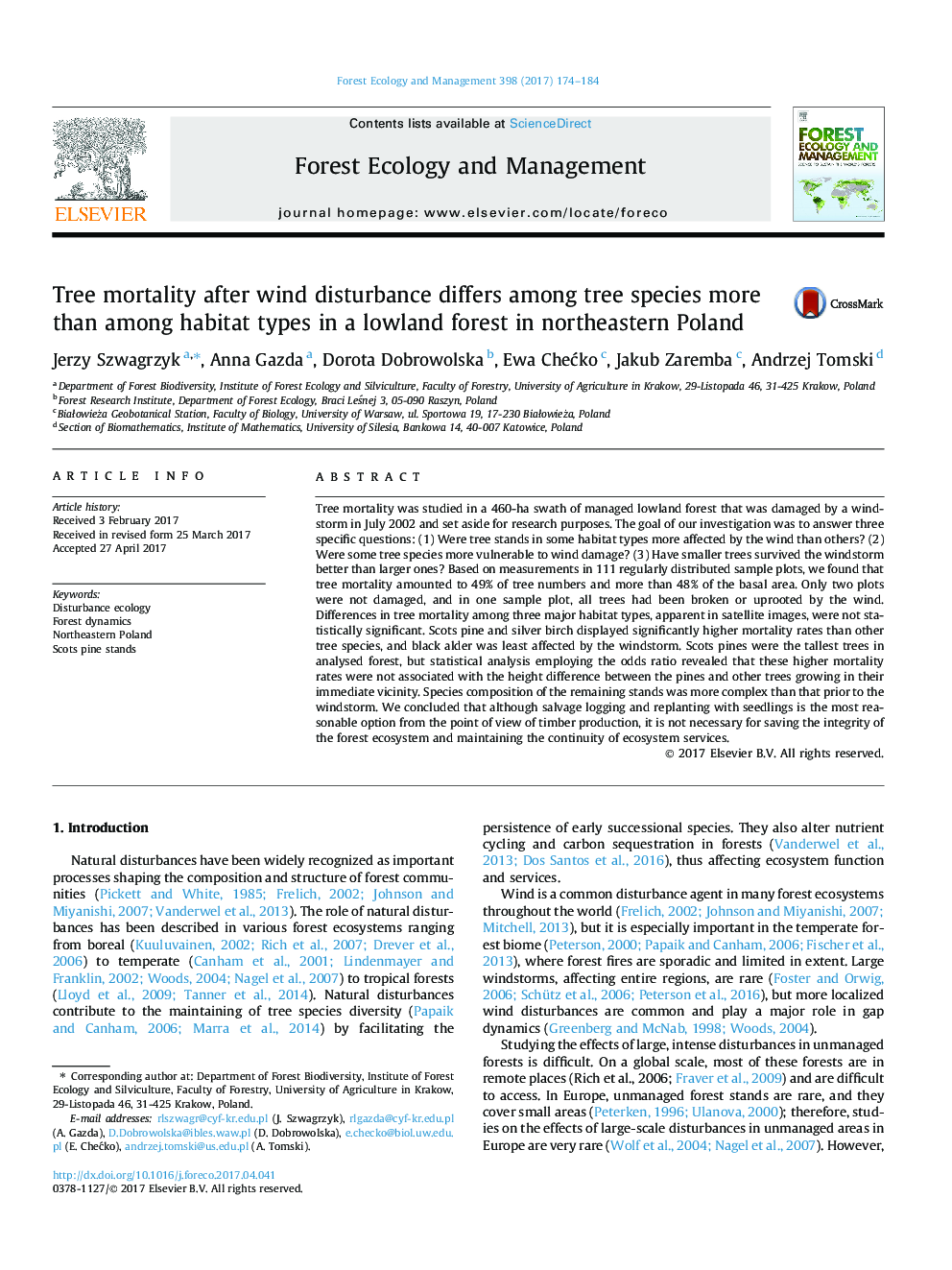| کد مقاله | کد نشریه | سال انتشار | مقاله انگلیسی | نسخه تمام متن |
|---|---|---|---|---|
| 4759401 | 1421360 | 2017 | 11 صفحه PDF | دانلود رایگان |
عنوان انگلیسی مقاله ISI
Tree mortality after wind disturbance differs among tree species more than among habitat types in a lowland forest in northeastern Poland
ترجمه فارسی عنوان
مرگ و میر درختان پس از اختلال باد در میان گونه های درختی بیشتر از گونه های زیستگاه در یک جنگل دشت در شمال شرقی لهستان متفاوت است
دانلود مقاله + سفارش ترجمه
دانلود مقاله ISI انگلیسی
رایگان برای ایرانیان
کلمات کلیدی
زیست محیط زیست، دینامیک جنگل، شمال شرقی لهستان، اسکاتلند کاج کاشت،
ترجمه چکیده
مرگ و میر درختان در یک ناحیه 460 هکتار جنگل دشتی مدیریت شده است که در ماه جولای 2002 آسیب دیدگی شدید و مورد هدف قرار گرفت. هدف از تحقیق ما پاسخ به سه سوال خاص بود: (1) آیا درختان در برخی از گونه های زیستگاه بیشتر تحت تأثیر باد نسبت به دیگران ایستاده اند؟ (2) آیا برخی از گونه های درختی آسیب پذیرتر به آسیب باد بود؟ (3) آیا درختان کوچکتر بهتر از انبوهی از وزش باد به سر می برند؟ بر اساس اندازه گیری ها در 111 نمونه توزیع شده به طور مرتب توزیع شده، ما دریافتیم که مرگ و میر درختی به میزان 49 درصد از تعداد درختان و بیش از 48 درصد از مناطق پایه است. فقط دو قطعه آسیب ندیده بود و در یک طرح نمونه، تمام درختان با باد ویران شده بودند. تفاوت های مرگ و میر درختان در میان سه نوع بزرگ زیستگاه، که در تصاویر ماهواره ای دیده می شود، از لحاظ آماری معنی دار نبود. کاج ساقه و ساقه نقره دارای میزان مرگ و میر قابل ملاحظه بیشتری نسبت به سایر گونه های درختی نشان می دهد و توسل سیاه به کمترین آسیب دیدگی است. کاج سنبله بلندترین درختان در جنگل های تجزیه شده بود، اما تجزیه و تحلیل آماری با استفاده از نسبت احتمال، نشان داد که این میزان مرگ و میر بالاتر با تفاوت ارتفاع بین کاج و درختان دیگر که در مجاورت آنها در حال رشد است نیست. ترکیب گونه های مانده های باقیمانده پیچیده تر از قبل بود. ما نتیجه گرفتیم که هر چند که ورود و خروج از جنگل با جوانه ها مناسب تر از نظر تولید چوب می باشد، صرفه جویی در یکپارچگی اکوسیستم جنگل و حفظ تداوم خدمات اکوسیستم لازم نیست.
موضوعات مرتبط
علوم زیستی و بیوفناوری
علوم کشاورزی و بیولوژیک
بوم شناسی، تکامل، رفتار و سامانه شناسی
چکیده انگلیسی
Tree mortality was studied in a 460-ha swath of managed lowland forest that was damaged by a windstorm in July 2002 and set aside for research purposes. The goal of our investigation was to answer three specific questions: (1) Were tree stands in some habitat types more affected by the wind than others? (2) Were some tree species more vulnerable to wind damage? (3) Have smaller trees survived the windstorm better than larger ones? Based on measurements in 111 regularly distributed sample plots, we found that tree mortality amounted to 49% of tree numbers and more than 48% of the basal area. Only two plots were not damaged, and in one sample plot, all trees had been broken or uprooted by the wind. Differences in tree mortality among three major habitat types, apparent in satellite images, were not statistically significant. Scots pine and silver birch displayed significantly higher mortality rates than other tree species, and black alder was least affected by the windstorm. Scots pines were the tallest trees in analysed forest, but statistical analysis employing the odds ratio revealed that these higher mortality rates were not associated with the height difference between the pines and other trees growing in their immediate vicinity. Species composition of the remaining stands was more complex than that prior to the windstorm. We concluded that although salvage logging and replanting with seedlings is the most reasonable option from the point of view of timber production, it is not necessary for saving the integrity of the forest ecosystem and maintaining the continuity of ecosystem services.
ناشر
Database: Elsevier - ScienceDirect (ساینس دایرکت)
Journal: Forest Ecology and Management - Volume 398, 15 August 2017, Pages 174-184
Journal: Forest Ecology and Management - Volume 398, 15 August 2017, Pages 174-184
نویسندگان
Jerzy Szwagrzyk, Anna Gazda, Dorota Dobrowolska, Ewa CheÄko, Jakub Zaremba, Andrzej Tomski,
